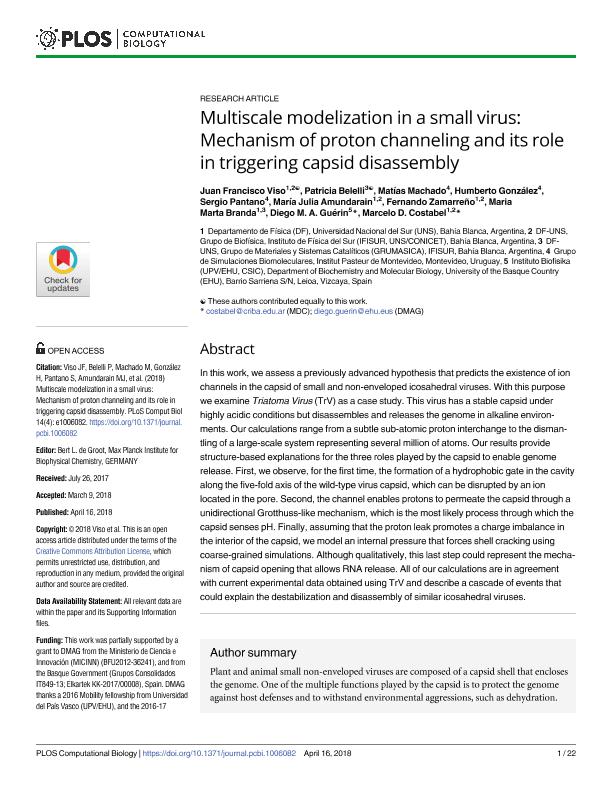Mostrar el registro sencillo del ítem
dc.contributor.author
Viso, Juan Francisco

dc.contributor.author
Belelli, Patricia Gabriela

dc.contributor.author
Machado, Matías Agustín

dc.contributor.author
Gonzalez, Humberto

dc.contributor.author
Pantano, Sergio
dc.contributor.author
Amundarain, María Julia

dc.contributor.author
Zamarreño, Fernando

dc.contributor.author
Branda, Maria Marta

dc.contributor.author
Guérin, Diego Marcelo Alejandro

dc.contributor.author
Costabel, Marcelo Daniel

dc.date.available
2020-01-15T17:46:29Z
dc.date.issued
2018-04-16
dc.identifier.citation
Viso, Juan Francisco; Belelli, Patricia Gabriela; Machado, Matías Agustín; Gonzalez, Humberto; Pantano, Sergio; et al.; Multiscale modelization in a small virus: Mechanism of proton channeling and its role in triggering capsid disassembly; Public Library of Science; Plos Computational Biology; 14; 4; 16-4-2018; 1-22
dc.identifier.issn
1553-734X
dc.identifier.uri
http://hdl.handle.net/11336/94750
dc.description.abstract
In this work, we assess a previously advanced hypothesis that predicts the existence of ion channels in the capsid of small and non-enveloped icosahedral viruses. With this purpose we examine Triatoma Virus (TrV) as a case study. This virus has a stable capsid under highly acidic conditions but disassembles and releases the genome in alkaline environments. Our calculations range from a subtle sub-atomic proton interchange to the dismantling of a large-scale system representing several million of atoms. Our results provide structure-based explanations for the three roles played by the capsid to enable genome release. First, we observe, for the first time, the formation of a hydrophobic gate in the cavity along the five-fold axis of the wild-type virus capsid, which can be disrupted by an ion located in the pore. Second, the channel enables protons to permeate the capsid through a unidirectional Grotthuss-like mechanism, which is the most likely process through which the capsid senses pH. Finally, assuming that the proton leak promotes a charge imbalance in the interior of the capsid, we model an internal pressure that forces shell cracking using coarse-grained simulations. Although qualitatively, this last step could represent the mechanism of capsid opening that allows RNA release. All of our calculations are in agreement with current experimental data obtained using TrV and describe a cascade of events that could explain the destabilization and disassembly of similar icosahedral viruses.
dc.format
application/pdf
dc.language.iso
eng
dc.publisher
Public Library of Science

dc.rights
info:eu-repo/semantics/openAccess
dc.rights.uri
https://creativecommons.org/licenses/by/2.5/ar/
dc.subject
TrV
dc.subject
Molecular Dynamics
dc.subject
QM/MM
dc.subject
Proton channel
dc.subject.classification
Biofísica

dc.subject.classification
Ciencias Biológicas

dc.subject.classification
CIENCIAS NATURALES Y EXACTAS

dc.subject.classification
Biofísica

dc.subject.classification
Ciencias Biológicas

dc.subject.classification
CIENCIAS NATURALES Y EXACTAS

dc.title
Multiscale modelization in a small virus: Mechanism of proton channeling and its role in triggering capsid disassembly
dc.type
info:eu-repo/semantics/article
dc.type
info:ar-repo/semantics/artículo
dc.type
info:eu-repo/semantics/publishedVersion
dc.date.updated
2019-10-22T17:35:47Z
dc.journal.volume
14
dc.journal.number
4
dc.journal.pagination
1-22
dc.journal.pais
Estados Unidos

dc.journal.ciudad
San Francisco
dc.description.fil
Fil: Viso, Juan Francisco. Universidad Nacional del Sur; Argentina
dc.description.fil
Fil: Belelli, Patricia. Consejo Nacional de Investigaciones Científicas y Técnicas. Centro Científico Tecnológico Conicet - Bahía Blanca. Instituto de Física del Sur. Universidad Nacional del Sur. Departamento de Física. Instituto de Física del Sur; Argentina
dc.description.fil
Fil: Machado, Matías Agustín. Instituto Pasteur de Montevideo; Uruguay
dc.description.fil
Fil: González, Humberto. Instituto Pasteur de Montevideo; Uruguay
dc.description.fil
Fil: Pantano, Sergio. Instituto Pasteur de Montevideo; Uruguay
dc.description.fil
Fil: Amundarain, María Julia. Consejo Nacional de Investigaciones Científicas y Técnicas. Centro Científico Tecnológico Conicet - Bahía Blanca. Instituto de Física del Sur. Universidad Nacional del Sur. Departamento de Física. Instituto de Física del Sur; Argentina
dc.description.fil
Fil: Zamarreño, Fernando. Consejo Nacional de Investigaciones Científicas y Técnicas. Centro Científico Tecnológico Conicet - Bahía Blanca. Instituto de Física del Sur. Universidad Nacional del Sur. Departamento de Física. Instituto de Física del Sur; Argentina
dc.description.fil
Fil: Branda, Maria Marta. Universidad Nacional del Sur; Argentina
dc.description.fil
Fil: Guérin, Diego Marcelo Alejandro. Universidad del País Vasco; España
dc.description.fil
Fil: Costabel, Marcelo Daniel. Universidad Nacional del Sur; Argentina
dc.journal.title
Plos Computational Biology

dc.relation.alternativeid
info:eu-repo/semantics/altIdentifier/url/http://dx.plos.org/10.1371/journal.pcbi.1006082
dc.relation.alternativeid
info:eu-repo/semantics/altIdentifier/doi/https://doi.org/10.1371/journal.pcbi.1006082
Archivos asociados
